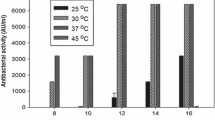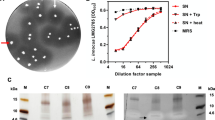Abstract
Carnocin KZ213 is an antilisterial bacteriocin produced by Carnobacterium piscicola 213. The effects of pH and temperature were studied during batch fermentation in MRS* medium (modified MRS without ammonium citrate or sodium acetate). The optimal pH for growth is between 6 and 7. The maximum bacteriocin productivity in the supernatant occurs at pH 7. Operating at controlled pH increases the volumetric activity of the free bacteriocin by 8- to 16-fold, compared with uncontrolled pH. No bacteriocin production is observed below pH 6.5. Temperature has a dramatic effect on carnocin KZ213 production. Growth is optimal at 25 °C and 30 °C, although no bacteriocin production is detected at 30 °C. Also, bacteriocin production is observed at 25 °C in MRS*, but not in complex APT broth, where growth is optimal. The presence of glucose as a carbon and/or energy source is important for carnocin KZ213 synthesis. Hence, bacteriocin synthesis is regulated by temperature, carbon source and medium composition. Quantification studies of bacteriocin adsorbed onto producer cells show that the majority of the carnocin KZ213 secreted is adsorbed onto the producer cells during growth. Only 15% of the total bacteriocin produced is detected in the cell-free supernatant at the end of growth.



Similar content being viewed by others
References
Aasen IM, Moretro T, Katla T, Axelsson L, Storro I (2000) Influence of complex nutrients, temperature and pH on bacteriocin production by Lactobacillus sakei CCUG 42687. Appl Microbiol Biotechnol 53:159–166
Ahn C, Stiles ME (1990) Plasmid-associated bacteriocin production by a strain of Carnobacterium piscicola from meat. Appl Environ Microbiol 56:2503–2510
De Man JC, Rogosa M, Sharpe ME (1960) A medium for the cultivation of lactobacilli. J Appl Bacteriol 23:130–135
De Vuyst L, Vandamme EJ (1992) Influence of carbon source on nisin production in Lactococcus lactis subsp. lactis batch fermentations. J Gen Microbiol 138:571–578
Diep DB, Axelsson L, Grefsli C, Nes IF (2000) The synthesis of the bacteriocin sakacin A is a temperature-sensitive process regulated by a pheromone peptide through a three-component regulatory system. Microbiology 146:2155–2160
Ennahar S, Sashihara T, Sonomoto K, Ishizaki A (2000) Class IIa bacteriocins: biosynthesis, structure and activity. FEMS Microbiol Rev 24:85–106
Guerra NP, Pastrana L (2003) Influence of pH drop on both nisin and pediocin production by Lactococcus lactis and Pediococcus acidilactici. Lett Appl Microbiol 37:51–55
Herranz C, Matinez JM, Rodriguez JM, Hernandez PE, Cintas LM (2001) Optimization of enterocin P production by batch fermentation of Enterococcus faecium P13 at constant pH. Appl Microbiol Biotechnol 56:378–383
Jack RW, Tagg JR, Ray B (1995) Bacteriocins of Gram-positive bacteria. Microbiol Rev 59:171–200
Khouiti Z, Simon JP (1997) Detection and partial characterization of a bacteriocin produced by Carnobacterium piscicola 213. J Ind Microbiol Biotechnol 19:28–33
Kozak W, Rajchert-trzpil M, Dobrzanski WT (1974) The effect of proflavin, ethidium bromide and an elevated temperature on the appearance of nisin-negative clones in nisin-producing strains of Streptococcus lactis. J Gen Microbiol 83:295–302
Montel MC, Talon R, Fournaud J, Champomier MC (1991) A simplified key for identifying homofermentative Lactobacillus and Carnobacterium spp from meat. J Appl Bacteriol 70:469–472
Mortvedt-Abildgaard CI, Nissen-Meyer J, Jelle B, Grenov B, Skaugen M, Nes IF (1995) Production and pH-dependent bactericidal activity of lactocin S, a lantibiotic from Lactobacillus sake L45. Appl Environ Microbiol 61:175–179
Parente E, Ricciardi A (1994) Influence on the production of enterocin 1146 during batch fermentation. Lett Appl Microbiol 19:12–15
Parente E, Ricciardi A (1999) Production, recovery and purification of bacteriocins from lactic acid bacteria. Appl Microbiol Biotechnol 52:628–638
Parente E, Ricciardi A, Addario G (1994) Influence of pH on growth and bacteriocin production by Lactococcus lactis subsp. lactis 140NWC during batch fermentation. Appl Microbiol Biotechnol 41:388–394
Ray B, Moltagh AM, Johnson MC (1993) Processing of prepediocin in Pediococcus acidilactici. FEMS Microbiol Rev 12:119
Schilinger U, Stiles ME, Holzapfel WH (1993) Bacteriocin production by Carnobacterium piscicola LV61. Int J Food Microbiol 20:131–147
Schillinger U, Geisen R, Holzapfel WH (1996) Potential of antagonistic microorganisms and bacteriocins for the biological preservation of foods. Trends Food Sci Technol 7:158–164
Stoffels G, Nes IF, Guomundsdottir A (1992) Isolation and properties of a bacteriocin-producing Carnobacterium piscicola isolated from fish. J Appl Bacteriol 73:309–316
Vignolo GM, Kairuz MN de, Ruiz Hologado AAP de, Oliver G (1995) Influence of growth conditions on the production of lactocin 705, a bacteriocin produced by Lactobacillus casei CRL 705. J Appl Bacteriol 78:5–10
Yang R, Ray B (1994) Factors influencing production of bacteriocins by lactic acid bacteria. Food Microbiol 11:281–291
Yang R, Johnson MC, Ray B (1992) Novel method to extract large amounts of bacteriocins from lactic acid bacteria. Appl Environ Microbiol 58:3355–3359
Author information
Authors and Affiliations
Corresponding author
Rights and permissions
About this article
Cite this article
Khouiti, Z., Simon, JP. Carnocin KZ213 produced by Carnobacterium piscicola 213 is adsorbed onto cells during growth. Its biosynthesis is regulated by temperature, pH and medium composition. J IND MICROBIOL BIOTECHNOL 31, 5–10 (2004). https://doi.org/10.1007/s10295-003-0104-7
Received:
Accepted:
Published:
Issue Date:
DOI: https://doi.org/10.1007/s10295-003-0104-7




